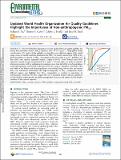Updated World Health Organization Air Quality Guidelines Highlight the Importance of Non-anthropogenic PM 2.5
Author(s)
Pai, Sidhant J; Carter, Therese S; Heald, Colette L; Kroll, Jesse H
DownloadPublished version (2.674Mb)
Publisher with Creative Commons License
Publisher with Creative Commons License
Creative Commons Attribution
Terms of use
Metadata
Show full item recordAbstract
The World Health Organization recently updated their air quality guideline for annual fine particulate matter (PM2.5) exposure from 10 to 5 μg m-3, citing global health considerations. We explore if this guideline is attainable across different regions of the world using a series of model sensitivity simulations for 2019. Our results indicate that >90% of the global population is exposed to PM2.5 concentrations that exceed the 5 μg m-3 guideline and that only a few sparsely populated regions (largely in boreal North America and Asia) experience annual average concentrations of <5 μg m-3. We find that even under an extreme abatement scenario, with no anthropogenic emissions, more than half of the world's population would still experience annual PM2.5 exposures above the 5 μg m-3 guideline (including >70% and >60% of the African and Asian populations, respectively), largely due to fires and natural dust. Our simulations demonstrate the large heterogeneity in PM2.5 composition across different regions and highlight how PM2.5 composition is sensitive to reductions in anthropogenic emissions. We thus suggest the use of speciated aerosol exposure guidelines to help facilitate region-specific air quality management decisions and improve health-burden estimates of fine aerosol exposure.
Date issued
2022Department
Massachusetts Institute of Technology. Department of Civil and Environmental EngineeringJournal
Environmental Science & Technology Letters
Publisher
American Chemical Society (ACS)
Citation
Pai, Sidhant J, Carter, Therese S, Heald, Colette L and Kroll, Jesse H. 2022. "Updated World Health Organization Air Quality Guidelines Highlight the Importance of Non-anthropogenic PM 2.5." Environmental Science & Technology Letters, 9 (6).
Version: Final published version